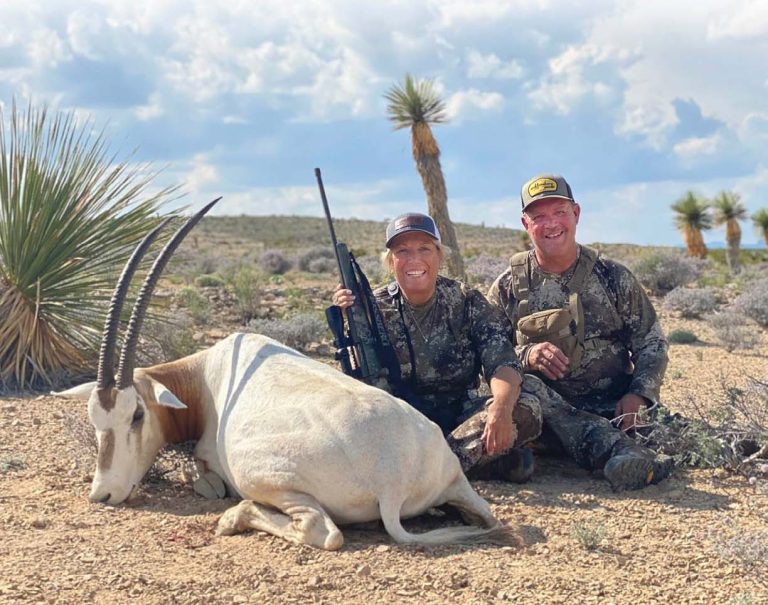The phone alarm woke me well before sunrise, and I was dressed and out the door within a minute. I was excited to get back into the field hunting. The Southwest Texas air was damp and the reflection of mountains in the water tank was inspiring. Recent rains brought the country to life, with the arid landscape storing its abundant beauty and being released with moisture. Birds sang, crickets chirped and the smell of wildflowers and cacti was a lovely welcome to a new day.
I was hunting scimitar-horned oryx with Steve Jones and his outfit, Backcountry Hunts. We had started our adventure the previous day and spotted several herds of oryx grazing the rough hill country. Hunting with Steve is always an adventure, and catching up with guide Dave Callaway was like a family reunion.
We stalked a herd of about 20 animals and ran into them atop a ridge. Why the herd decided to move while we were stalking is unknown, but they did not like the looks of us. The herd took off on the run, and we watched as they were still on the move almost three miles away. Any thoughts of the hunt being easy were quickly diminished. Finding animals was not an issue. The animals’ white and rusty tan colorations stood out at a distance. Getting remotely close to the critters proved to be challenging.
In most cases, the animals were off and running when they saw a vehicle. We revised our strategy and walked to vantage points to find animals before they could see us. Late in the evening, we watched a herd of oryx work over a plateau, and we hoofed it about a mile to try and sneak over the top and catch them below. Unfortunately, they had covered more ground than we had and were almost out of sight when we found them again. The sandy ground was poked with hoof tracks, letting us know the ridge was a regular travel corridor.
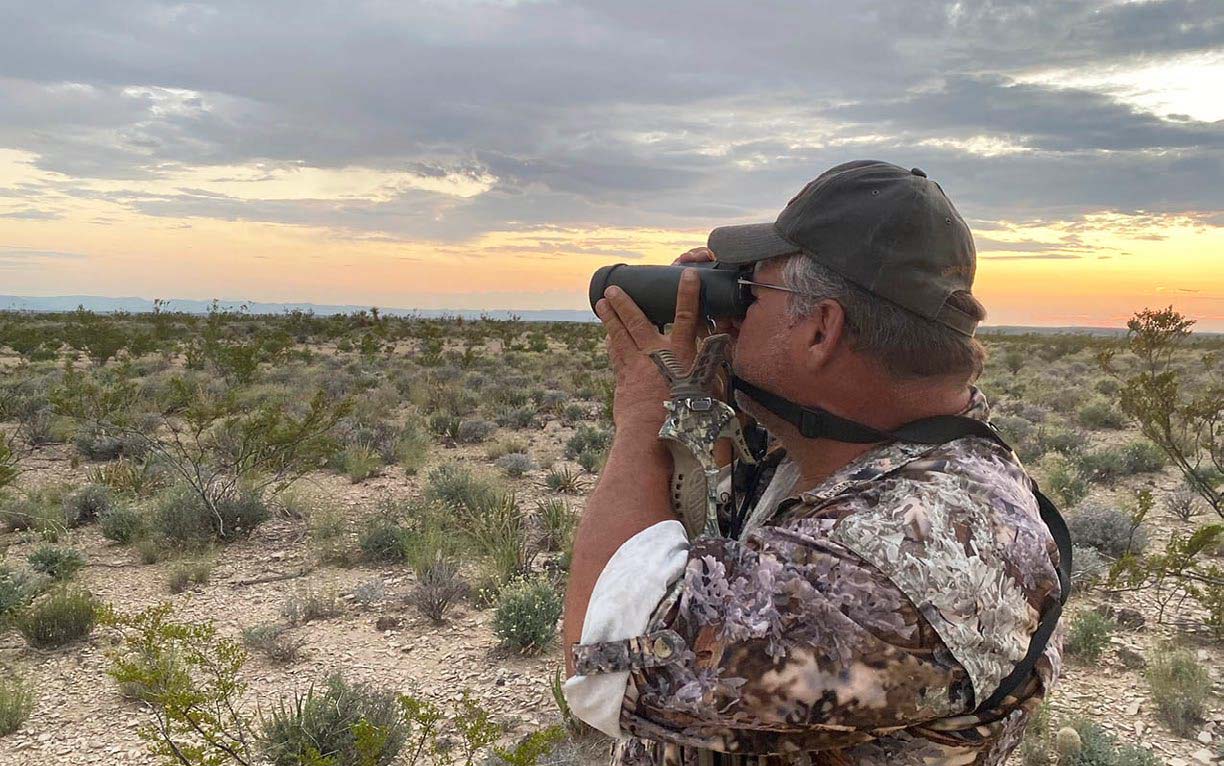
Rough Country
Our second day afield proved to be as challenging as the first. We spotted seven different herds of oryx but were unsuccessful at getting close enough for a shot. Sometimes, the animals were lucky to have moved at the last minute. Other times, a single oryx would spot us and the entire herd would be off on the run.
The country was extremely rough, with sharp rocks, thorns and cactus everywhere. We were traveling by a truck outfitted with solid tires. A regular tire would not last 15 minutes in this unforsaken country. Our big and aggressive tires went places that surprised me. The pace was slow and steady, but it saved us miles of walking and allowed us to explore the far reaches of the giant ranch.
Day three started with a spectacular sunrise, and we were back glassing the hills for an elusive oryx. A lone bull was spotted on a distant fence line and we scurried to try and get into position. Once again, the oryx took a lucky turn and was spotted far in the distance, nowhere near where we had stalked. Several animals were working in the area, and we parked beside a large dam to get a better vantage point. We had been sitting for about 40 minutes when a young bull appeared at the base of the hill, about 100 yards below. After seeing many large bulls, it was an easy decision to pass on this bull, even if it would have been easy.
We spotted two bulls working their way up a ridge late in the day. We decided to get to the other side and work our way up the ridge. With any luck, the bulls would stay in the same area, allowing us to peek over the top and locate them within range. We headed out, watching every step to avoid cactus and jagged rocks. We were about 300 yards from the top when I spotted horns coming over the top. We froze in our tracks and watched the first bull wander towards us. The second bull appeared about 100 yards over and worked down the ridge.
I set up on a set of Primos Trigger Sticks and found the bull in my scope. I had time to adjust the power and set the parallax on the Leupold VX6 HD riflescope to ensure an accurate shot. The bull was over 250 yards out and slowly grazing. I tightened on the trigger as the sun sank into the western sky. The bullet finding solid mass provided an audible on a direct hit. The oryx ran and quickly disappeared into a bowl. We watched for a minute but saw nothing run out of the land depression.
We clamored up the hill as fast as possible and found the oryx lying in the rocks about 80 yards from where it was standing. The colorful sky made a perfect backdrop for quick photos before returning to camp for oryx steaks and a hot dinner. The oryx was earned, and the hunt was memorable in every way.
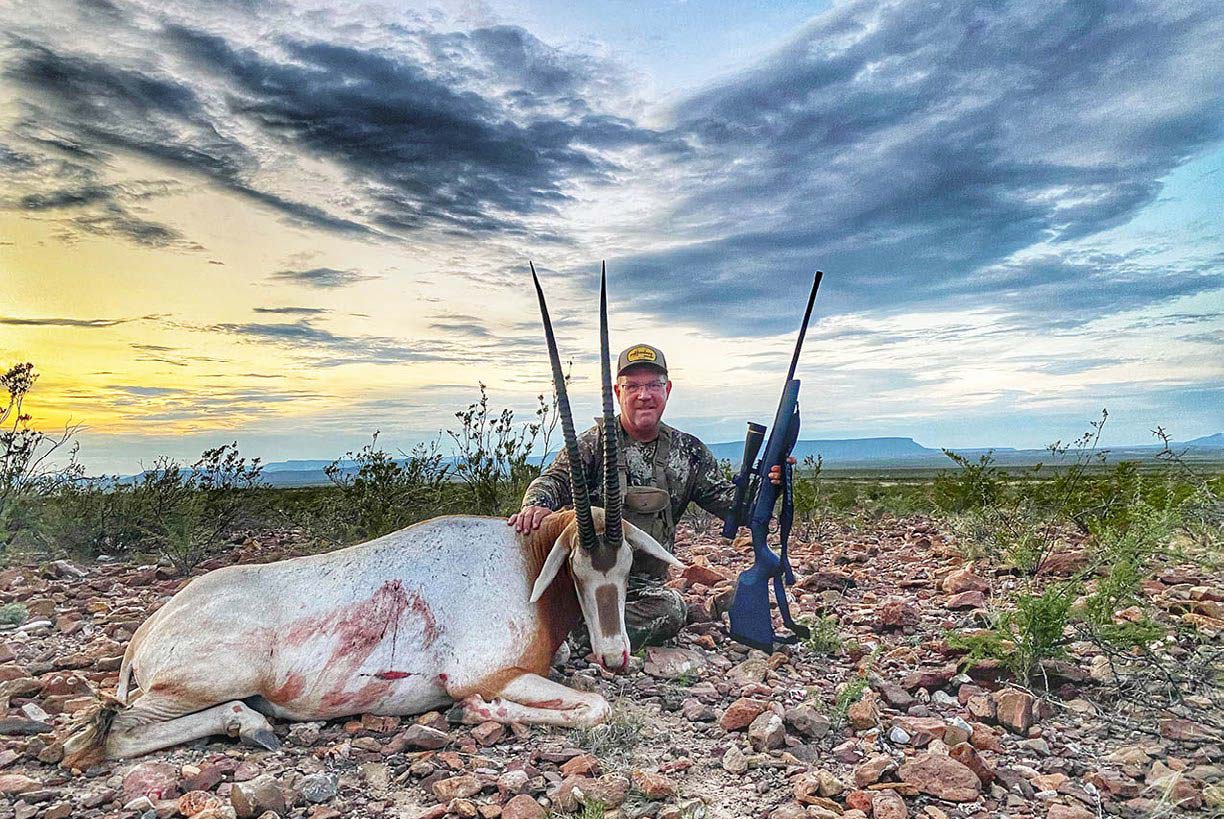
Trip Highlight
A highlight of the trip was spending the next day hunting with longtime friend Linda Powell. I rode in the truck’s top rack to spot animals as soon as possible. The oryx were spooky, and the high winds made hunting even more challenging.
We were heading across a plateau when I spotted two bulls approaching a ridge. I pounded on the truck’s roof, and the animal instantly stopped. The largest bull was putting the run on a younger bull, which likely meant a herd of cows was close. The young bull headed over the plateau, and the bigger one returned to the valley below the ridge. We let the area settle for a few minutes before working to where the bull was last seen.
Every step was taken cautiously, peeking into every draw to try and locate the animals. We finally reached the last ridge and knew the animals must be below. Taking one step at a time, we crept down the ridge, watching carefully. The big bull we had seen appeared on the valley floor chasing another young bull. We stood and watched the performance, and the big bull ran back towards our ridge, satisfied the competition was gone. We could hear oryx vocalizing below and crept down the spine of the ridge. Several cows and calves came into view, and a few steps further provided a bird’s-eye view of the entire herd. The bull was walking back towards his harem, and Linda got set up on the shooting sticks.
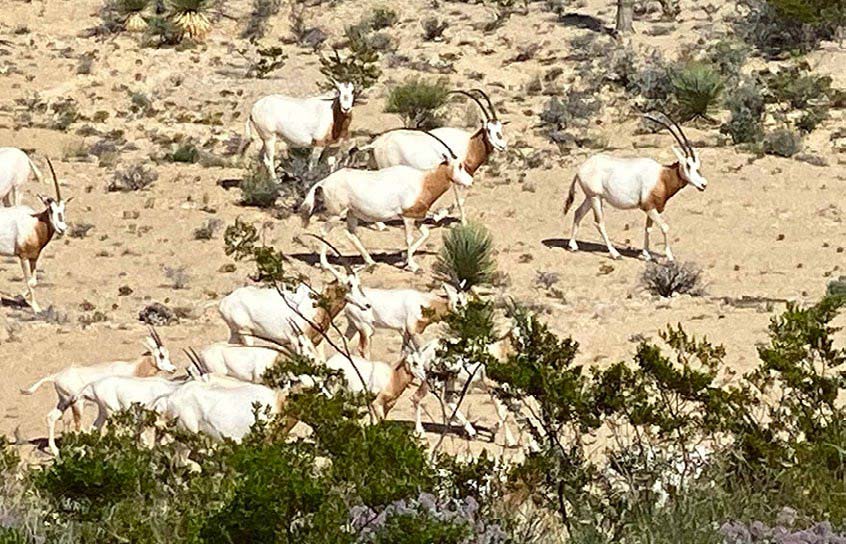
The bull looked grand as he marched proudly toward his ladies. We were closer to the herd of oryx than we had been to any other animals all week. The wind kept the animals below the ridge and covered any noise we might have made. Linda lined up on the bull and Dave told her to shoot when ready. The bull walked to the base of the ridge, turned broadside and the rifle’s report was synonymous with it falling to the ground. The rest of the herd did not know what happened and milled for several minutes before walking up the draw and over the ridge. It was an incredible show and a highlight of a unique hunt.
The scimitar-horned oryx is a unique animal that can only be hunted as an exotic. It is extinct in its home range of Northern Africa but it is thriving in the harsh conditions of Southwest Texas. I have never hunted an extinct species, and doubt there will be many chances to do it with other species. At least, we hope.
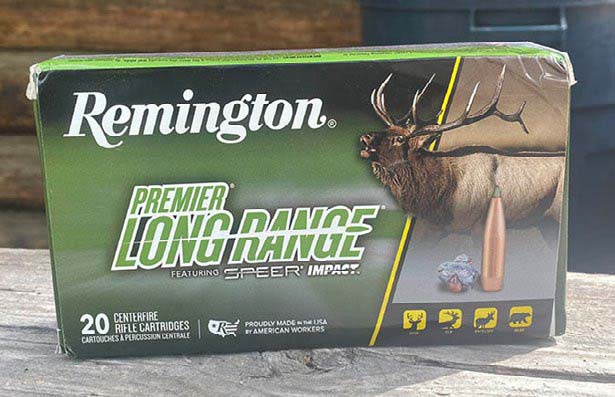
Remington Premium Long Range Featuring Speer Impact
Remington Ammunition was the first to load a Speer Impact bullet commercially, creating a cartridge designed to perform at both short and long ranges. The Impact bullet has a Slipstream tip and a high ballistic coefficient. The features work to initiate expansion at any speed. The bullet is chemically fused to avoid separation, allowing it to retain energy and weight upon impact. The boat-tail bullet is rear-adjusted for the center of gravity to improve aerodynamics for consistent flight and long-range accuracy. Top-grade primers and powders round out the premium cartridge for reliable performance in any environment.
Jon Langenfeld, the head engineer on the project, was on the oryx hunt and explained that the projectile’s sleek and tightly-tapered hybrid ogive with its boat tail creates a high ballistic coefficient. The result is match-grade accuracy and advantages.
Flat trajectory, bonded bullet, long-range accuracy and premium components make Premier Long Range as close as possible to a custom cartridge in a telltale green Remington box. The initial offering will include 6 mm Creedmoor with 109 grain, 6.5 Creedmoor with 140 grain, 270 WIN. with 150 grain, 7 mm REM MAG with 175 grain, 30-06 Spring with 172 grain, 308 WIN 172 grain, 300 WIN MAG 190 grain, and 300 REM Ultra Mag 190 grain. For more information, visit the website.
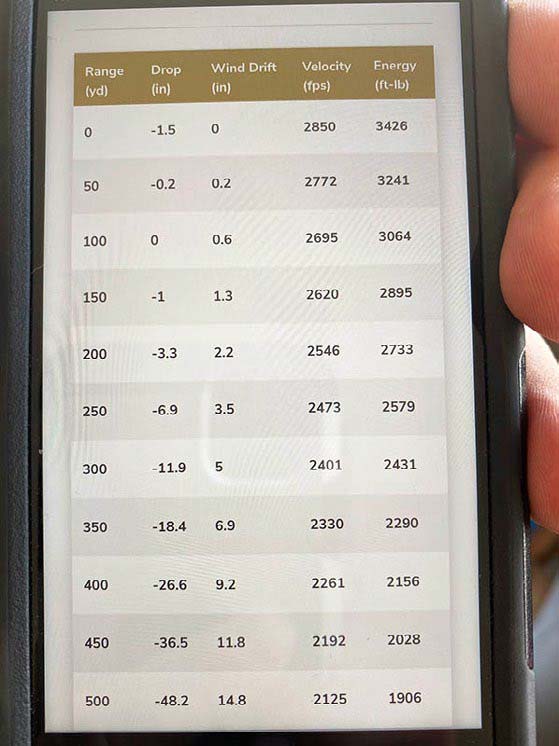
Mossberg Patriot LR rifle
The Mossberg Patriot LR (Long Range) Hunter was the perfect rifle to test the new Remington long-range cartridge. The rifle design takes every detail into account to ensure long-range performance. The Patriot LR Hunter stock offers precise contours for comfort and accuracy. The Monte Carlo elevated comb combines with the optics top rail to make sighting and target acquisition intuitive. The stock has a polymer-coated, Spider Gray finish textured with a special micro-textured surface offering comfort and firm grip at the range or in harsh environments. Mossberg has gone the extra mile, fitting the stock with machined aluminum bedding pillars for stability.
A benchrest-style forend is flat for use with a rest or stabilizing device and it tapers towards the barrel for comfort and grip. The barrel is fluted and threaded, making it muzzle brake or suppressor ready, and it includes a protective thread cap and 11-degree match crown. Dual swivel studs are included to attach a bipod and sling. Standard Patriot features include a drop box magazine, spiral fluted bolt, patented LBA user-adjustable trigger (2 to 7 pounds) and an oversized bolt handle.
The rifle shot sub-MOA at the range and proved deadly accurate in the open country of the keen-eyed oryx. For more information, models, and caliber options, visit the website.

Scimitar-Horned Oryx
Simitar oryx, known as scimitar-horned oryx or Sahara oryx, were once abundant across North Africa. In 2000, they were declared extinct in the wild. Captive breeding programs have been successful in Texas and Morocco, as well as Senegal. For several years in the United States, the species created some uproar in the hunting community when they were not allowed to be hunted. Ironically, hunting has allowed the species to flourish and generate value for an animal that disappeared from its country of origin (Chad). In 2016, oryx from Texas were reintroduced to Chad to reestablish a population.
Oryx are highly adapted to life in the desert. They can go months or even years without drinking water and can eke out a living by grazing in harsh environments. Male oryx can weigh up to 450 pounds and are over three feet tall at the shoulder. The males have thick, heavy horns and the females tend to be slender. Both sexes have long horns that sweep backward with a slight curve. It is not uncommon to see oryx with broken horns from fighting. It is fabled that a one-horned oryx may be the original sighting of a unicorn. Oryx are tremendous table fare, which may have been part of their demise. Egyptians once domesticated oryx and used them for meat and leather.
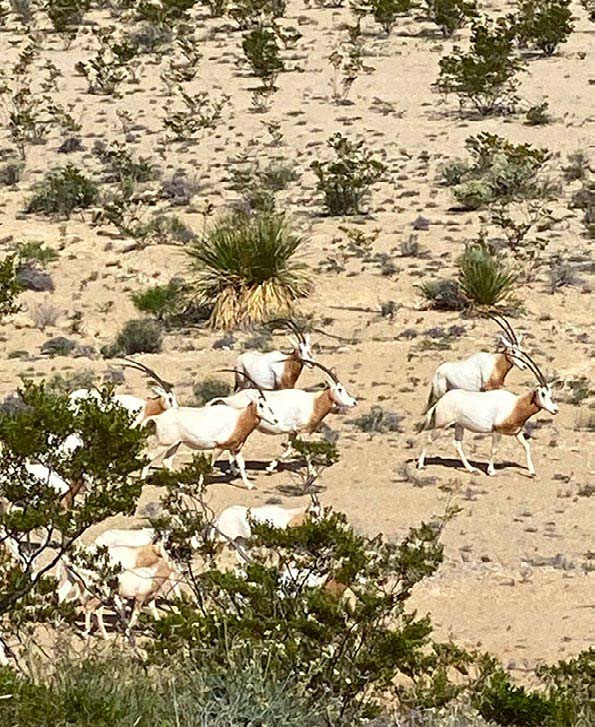
Outfitter: Steve Jones, Backcountry Hunts
Steve has been outfitting in Texas and New Mexico since 1984. The home-cooked meals and great accommodations he provides are always welcome, whether you are staying in a ranch house or sleeping in a teepee camp. Jones hunts various big game, including exotics, elk, mule deer, Whitetails, mountain lions and more. Simitar oryx is one of the exotics that make a challenging and fun hunting adventure.
Contact him as follows:
Steve Jones
1029 Haston Road
Carlsbad, NM 88220
(575) 887-6178 – office
(575) 361-1053 – cell
(480) 768-6122 – Saturdays
[email protected]
Per our affiliate disclosure, we may earn revenue from the products available on this page.



